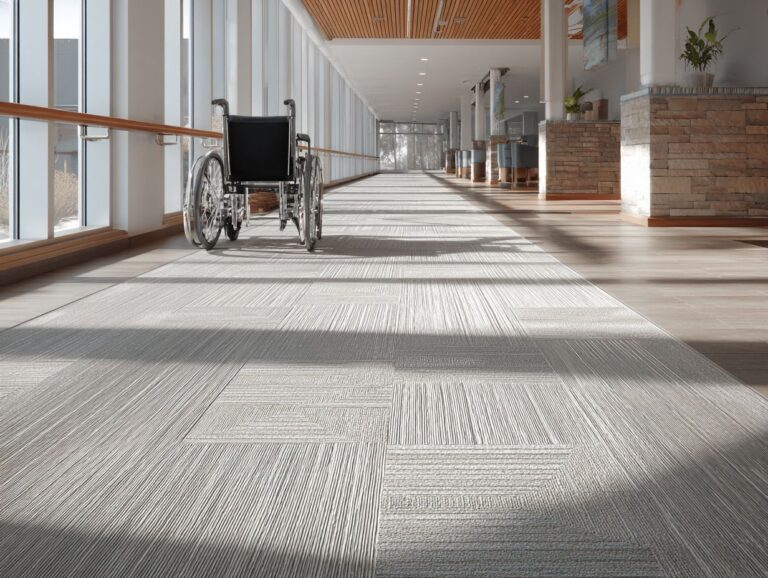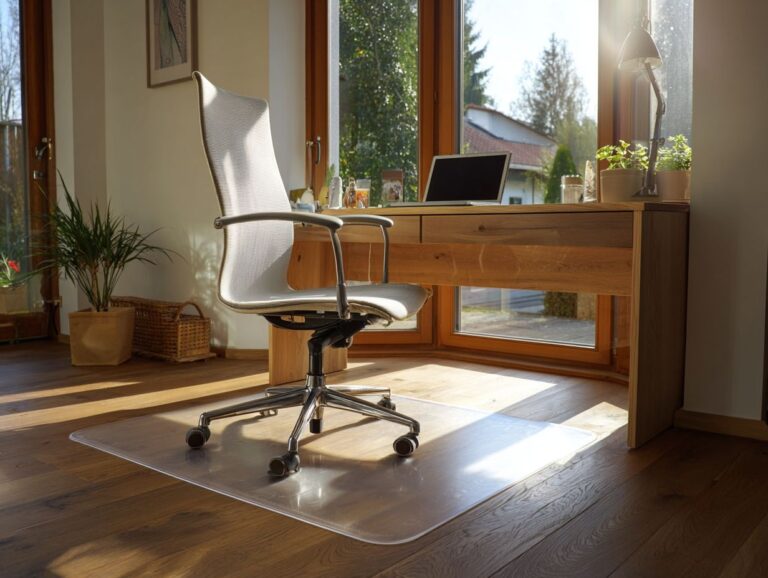Vinyl Flooring VOC Emissions – Safety and Health Guide
Are you concerned about volatile organic compounds (VOCs) in your home? Vinyl flooring can release these harmful substances through off-gassing, impacting your indoor air quality. Common sources include flooring, household cleaning products, and formaldehyde found in certain materials. This guide on safety and health will help you pick vinyl flooring, understand VOC emissions, and provide tips for making informed home improvement choices to keep your family healthy.
Key Takeaways:
Contents
- Understanding VOCs
- VOCs in Vinyl Flooring
- Vinyl Flooring VOC Emissions Statistics
- Health Effects of VOC Emissions
- Regulations and Standards
- Testing for VOC Emissions
- Reducing VOC Emissions
- Frequently Asked Questions
- What are vinyl flooring VOC emissions?
- Why is it important to think about safety and health regarding vinyl flooring VOC emissions?
- Do all vinyl flooring products release the same amount of VOCs?
- What are some potential health effects of vinyl flooring VOC emissions?
- How can I reduce my exposure to vinyl flooring VOC emissions?
- Are there any alternatives to vinyl flooring with lower VOC emissions?
What is Vinyl Flooring?

Vinyl flooring is a synthetic flooring option made primarily from polyvinyl chloride (PVC), designed to mimic the appearance of natural materials like wood or stone.
Its composition includes multiple layers: a backing for stability, a design layer for visuals, and a wear layer for durability. Vinyl flooring is attractive and durable, resisting water, scratches, and stains, which makes it a common choice for homes and businesses.
Homeowners often choose it for kitchens and bathrooms due to its water-resistant nature, while businesses value its ability to withstand high foot traffic. It combines beauty, practicality, and affordability.
Types of Vinyl Flooring
There are primarily two types of vinyl flooring: luxury vinyl tile (LVT) and sheet vinyl, each offering unique benefits and aesthetic appeal.
LVT comes in separate tile pieces and is very strong, which makes it ideal for busy areas such as dining rooms and businesses. For those interested in the detailed differences between luxury vinyl plank and tile, this Luxury Vinyl Plank (LVP) vs Luxury Vinyl Tile (LVT) Guide can provide deeper insights.
The printing technology makes wood and stone finishes look realistic, attracting consumers who want high-quality appearance. In contrast, sheet vinyl comes in large rolls, providing seamless installation that’s water-resistant and ideal for kitchens and bathrooms.
Its affordability and easy maintenance make it a practical choice for families or rental properties, ensuring both style and functionality.
Understanding VOCs
Volatile organic compounds (VOCs) are chemicals made of carbon that quickly become gases at room temperature, which can be harmful to health indoors.
Definition of VOCs
VOCs are a class of chemicals that include a variety of organic compounds, often found in household items, contributing to poor indoor air quality.
These chemicals can turn into gas at normal temperatures, which is why they are present in common items such as paints, cleaning products, and air fresheners.
For instance, common sources of VOCs include new paint that may contain solvents, aerosol sprays, and even some furniture finishes.
To reduce exposure, pick products with low or no VOCs and make sure to have good airflow when using items with high VOCs. Regularly airing out your space can significantly improve indoor air quality by reducing VOC concentration.
Common Sources of VOCs
Common sources of VOCs include household cleaning products, paints, adhesives, and even building materials like vinyl flooring, which can significantly impact indoor air quality.
Specific household cleaning products often contain VOCs, such as aerosol sprays and some detergents. For instance, air fresheners may emit formaldehyde, while certain paints can release high levels of toluene.
Flooring options like vinyl may leach phthalates, especially in lower-quality products. To reduce these risks, think about using paints and flooring that have low or no volatile organic compounds (VOCs). For example, Benjamin Moore has low-VOC paints, and you can get GreenGuard-certified vinyl flooring to improve indoor air quality.
When shopping, always check labels and prioritize products verified as low in VOC emissions.
VOCs in Vinyl Flooring
Vinyl flooring can release VOCs because of how it’s made and what it’s made from, causing worry for people who care about health.
Vinyl Flooring VOC Emissions Statistics
Vinyl Flooring VOC Emissions Statistics
The Vinyl Flooring VOC Emissions Statistics The dataset focuses on solving the important problem of VOC emissions linked to vinyl flooring. VOCs are chemicals that can easily evaporate at room temperature and may have adverse health effects, including respiratory issues, headaches, and other symptoms. Learning about VOC emissions from vinyl flooring helps people make better choices for their homes and workplaces.
Though the dataset contains no specific metrics, it raises important considerations:
- Health Implications: High levels of VOC emissions can deteriorate indoor air quality and contribute to health problems. Researching and choosing low-VOC vinyl flooring options can mitigate these risks.
- Regulatory Standards: Different countries and regions have various regulations concerning VOC emissions. Learning these standards helps follow rules and supports better living environments.
- Consumer Awareness: More and more consumers want flooring that is good for the environment and safe to use. Vinyl flooring manufacturers must prioritize transparency in VOC emissions to meet these demands.
- Technological Innovations: Advances in flooring technology can reduce VOC emissions. Investing in research and adopting innovative manufacturing processes can lead to safer products.
Although the Vinyl Flooring VOC Emissions Statistics The dataset does not give exact numbers but highlights the need to manage VOC emissions in vinyl flooring. Manufacturers, consumers, and regulators need to work together to create flooring options that are safe and good for the environment.
How VOCs are Released

VOCs are given off through a process where these substances change from liquid to gas and enter the air. This usually happens most during the first few days after installation.
Gas emissions can occur for a period ranging from a few days to a few weeks. Factors influencing this release include room temperature, ventilation, and the specific type of vinyl flooring.
For instance, warmer temperatures can accelerate the evaporation of VOCs, while good ventilation helps dilute and disperse them more quickly. To minimize exposure, consider operating fans or opening windows during and after installation.
Picking flooring with low or no VOCs can cut down health risks and make your home safer.
Types of VOCs Found in Vinyl Flooring
Common VOCs found in vinyl flooring include formaldehyde, phthalates, and acetaldehyde, which are linked to various health risks.
Formaldehyde, often released from adhesives and resins, can cause respiratory issues and has been classified as a carcinogen.
Phthalates, often used to make vinyl more flexible, are linked to hormone problems and developmental issues. Acetaldehyde, a byproduct of vinyl combustion, may irritate the eyes and throat.
These compounds are particularly prevalent in affordable or older vinyl products, such as tiles and sheets, manufactured before stricter regulations were imposed.
For safer options, consider low-VOC or phthalate-free vinyl flooring alternatives that adhere to stricter emission standards.
Health Effects of VOC Emissions
Breathing in chemicals released from vinyl flooring can cause health problems now and over time, so it’s important for homeowners to be informed.
Short-term Health Effects
Short-term exposure to VOCs may result in symptoms such as headaches, nausea, and irritation of the eyes and throat, particularly in poorly ventilated spaces.
In fact, studies have shown that individuals in newly renovated homes often report significantly higher instances of these symptoms. For example, a 2019 study indicated that 30% of residents in such homes experienced eye irritation and headaches, with many attributing these issues to paint and cleaning products.
To lessen these effects, make sure to have good airflow by opening windows or using air purifiers. Opting for low-VOC or VOC-free paints and cleaners can help reduce exposure and improve indoor air quality significantly.
Long-term Health Effects
Long-term exposure to certain VOCs has been associated with serious health conditions, including chronic obstructive pulmonary disease and potential carcinogenic effects.
Studies from organizations like the American Lung Association indicate that VOCs, found in common household products such as paints, cleaners, and air fresheners, can lead to respiratory issues and increased cancer risk. For example, benzene, a VOC present in many solvents, has been linked to leukemia after prolonged exposure.
To mitigate these risks, consider using low-VOC or VOC-free products, improving ventilation when using chemical products, and regularly checking air quality indoors. Using these steps can greatly improve your home and support healthier living.
Regulations and Standards
Rules about VOCs are created to protect the quality of indoor air, with different guidelines set by groups such as the California Air Resources Board (CARB).
Overview of VOC Regulations
VOC regulations vary by region, with strict standards enforced by the CARB, which limit the amount of VOCs allowed in various products including flooring.
The California Air Resources Board (CARB) has set strict rules that manufacturers need to follow to make sure vinyl flooring products are safe. These standards include limits on formaldehyde and other harmful compounds, aimed at reducing indoor air pollution.
For consumers, selecting CARB-compliant products guarantees lower emissions and a healthier environment. Companies can achieve compliance by utilizing low-VOC adhesives and finishes during production.
Regular audits and testing are necessary to keep these standards, which build consumer trust and help in selling products in eco-friendly markets.
Industry Standards for Vinyl Flooring

Industry standards like FloorScore certification confirm that vinyl flooring products have low VOC emission levels for better safety.
This certification shows that a product has gone through strict testing for volatile organic compounds and guarantees consumers a safer indoor space.
For example, brands like Karndean and Armstrong provide FloorScore certified flooring, which makes them great for houses with kids or animals.
Look for certifications such as Greenguard Gold, which further emphasizes low chemical emissions and improves indoor air quality.
When choosing vinyl flooring, focus on these certifications for a safe and eco-friendly option.
Testing for VOC Emissions
Checking VOC emissions is important to verify the safety of flooring products and confirm they comply with health standards.
Methods of Testing
Common methods for testing VOC emissions include chamber tests, field tests, and using specialized monitoring equipment like photoionization detectors.
Chamber tests check VOC levels by placing samples in enclosed areas to measure them accurately. This controlled setup lets us measure the emissions from a product precisely.
Field tests occur in real-world settings, measuring actual emissions over time to demonstrate product performance in typical usage.
Photoionization detectors (PIDs) offer immediate measurements and can identify various VOCs based on their ionization potential.
Using these methods together follows EPA guidelines, ensuring thorough evaluation and meeting industry standards.
Understanding Test Results
Interpreting VOC test results means looking at emission levels and checking if they meet safety standards.
To effectively interpret your VOC test results, focus on three main metrics: Total VOCs (TVOCs), specific chemical concentrations, and their corresponding safety limits.
For instance, a TVOC level below 500 g/m is generally considered acceptable, while levels above 1,000 g/m can be concerning. Pay close attention to specific compounds like benzene, which should ideally remain under 5 g/m.
If your results indicate higher levels, consider using air purification systems or improving ventilation to reduce concentrations effectively.
Reducing VOC Emissions
You can lower VOC emissions in your home by choosing materials with low VOC content and following recommended methods when installing them. Worth exploring: our Luxury Vinyl Plank (LVP) vs Luxury Vinyl Tile (LVT) Guide for more insights on selecting eco-friendly flooring options.
Choosing Low-VOC Options
When selecting vinyl flooring, look for products labeled as low-VOC or certified by organizations like CARB or FloorScore to minimize indoor air pollution.
Consider brands like Armstrong, which offers a range of low-VOC options that also feature the FloorScore certification. Alternatively, Shaw’s vinyl line is known for its sustainability and durability, ensuring a good balance between eco-friendliness and performance.
Always check the Environmental Product Declaration (EPD) to learn more about the materials used.
You can usually install low-VOC flooring over a weekend with regular tools. This makes it a doable project for homeowners looking to improve indoor air quality.
Installation Best Practices
Adhering to best installation practices, such as ensuring proper ventilation and using low-VOC adhesives, can greatly reduce VOC emissions from flooring.
To further minimize VOC emissions, consider the timing of your installation. Choose cooler days to open windows and improve airflow.
Use materials like bamboo or reclaimed wood, which naturally emit fewer toxins. Before installation, acclimate your flooring materials in the space, allowing them to adjust to room temperature.
Avoid solvent-based finishes, instead selecting water-based alternatives that dry quickly and emit significantly fewer VOCs.
By combining these strategies, you’ll create a healthier environment while maintaining a high-quality flooring installation.
Post-Installation Management

Post-installation management involves strategies such as maintaining good ventilation and using air purifiers to mitigate any residual VOCs from flooring.
-
To improve air quality inside, open windows and use exhaust fans to increase airflow for at least 72 hours after installation.
-
Consider investing in a HEPA air purifier, which can effectively capture airborne pollutants, with options like the Coway AP-1512HH priced around $250.
-
Change your HVAC filters every 1-3 months to keep your system working well.
-
Monitor humidity levels using a hygrometer; keeping it between 30-50% can prevent mildew and promote a healthier indoor environment.
Summary of Key Points
Key points include identifying the types of VOCs in vinyl flooring, learning about their health effects, and knowing how to select safer options.
To choose safer vinyl flooring, focus on products labeled “low-VOC” or “no-VOC.” Look for certifications such as FloorScore or GreenGuard, which show that the products have been tested thoroughly for indoor air quality.
Consider opting for luxury vinyl tiles (LVT) that are often made with fewer harmful chemicals. When installing, make sure there is good airflow to lower the risk of breathing in fumes during and after the work, as these can last for days or even weeks.
Doing these things makes your home cleaner and helps you and your family live healthier.
Resources for Further Information
For further information on VOCs and safe flooring options, consult resources such as the American Lung Association and CARB’s official website.
The Environmental Protection Agency (EPA) offers detailed advice on indoor air quality and VOCs, serving as a useful reference point.
To get practical tips on choosing flooring materials with low VOCs, check out The Flooring Store’s online guide. It looks at different products and certifications.
The Green Building Council provides information on eco-friendly building methods, such as flooring choices that reduce indoor pollution. These resources help you make well-informed choices to improve indoor air quality and keep things safe.
Frequently Asked Questions
What are vinyl flooring VOC emissions?
VOC stands for volatile organic compounds, which are chemicals that can easily become gases and are often found in products like vinyl flooring. These emissions can be released into the air and potentially impact indoor air quality.
Why is it important to think about safety and health regarding vinyl flooring VOC emissions?
Vinyl flooring VOC emissions can have negative effects on both human health and the environment. It is important to understand the potential risks and take necessary precautions to protect yourself and those around you.
Do all vinyl flooring products release the same amount of VOCs?
No, not all vinyl flooring products are the same. Some may have lower levels of VOC emissions than others. It is important to research and compare products to find the best option for your safety and health concerns.
What are some potential health effects of vinyl flooring VOC emissions?
Exposure to high levels of VOC emissions from vinyl flooring can cause irritation to the eyes, nose, and throat, as well as headaches, dizziness, and respiratory issues. Long-term exposure may also lead to more serious health problems.
How can I reduce my exposure to vinyl flooring VOC emissions?
There are a few ways to reduce your exposure to vinyl flooring VOC emissions. These include choosing flooring products with lower VOC emissions, increasing ventilation in the space, and regularly cleaning and maintaining the flooring to prevent buildup of emissions.
Are there any alternatives to vinyl flooring with lower VOC emissions?
Yes, there are alternative flooring options available that have lower levels of VOC emissions, such as hardwood, bamboo, and cork flooring. It is important to research and compare products to find the best option for your specific needs and preferences.





